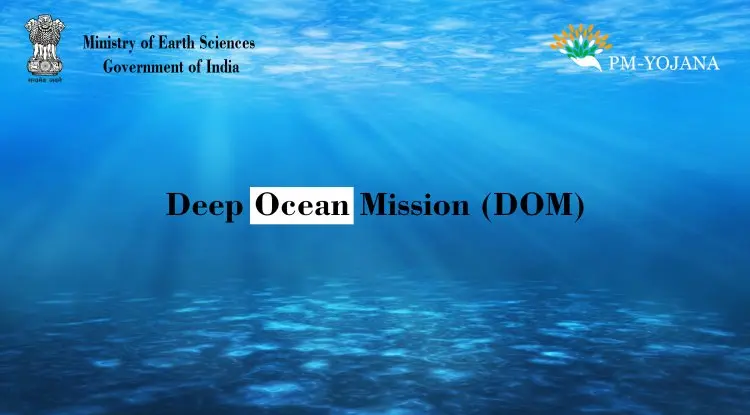deep ocean mission
A research vessel for deep ocean exploration would be built in an Indian shipyard which would create employment opportunities.

deep ocean mission
A research vessel for deep ocean exploration would be built in an Indian shipyard which would create employment opportunities.
Deep Ocean Mission
Why in News
Recently, the Cabinet Committee on Economic Affairs has approved the proposal of the Ministry of Earth Sciences (MoES) on the Deep Ocean Mission (DOM).
- The blueprint of the DOM to explore the deep recesses of the ocean was unveiled in 2018. Earlier, MoES had also rolled out the draft Blue Economy Policy.
Key Points
- About:
- The cost of the Mission has been estimated at Rs. 4,077 crore over a five-year period and will be implemented in phases. MoES will be the nodal ministry implementing this multi-institutional ambitious mission.
- It will be a mission mode project to support the Blue Economy Initiatives of the Government of India.
- Blue Economy is the sustainable use of ocean resources for economic growth, improved livelihoods and jobs, and ocean ecosystem health.
- The technology and expertise needed in such missions is now available with only five countries - US, Russia, France, Japan and China.
- India will now be the sixth country to have it.
- About:
About the Deep Ocean Mission
- The mission has been laid on similar terms as the Indian Space Research Organisation (ISRO) performs space research
- However, India’s Deep Ocean Mission will solely focus on studying and exploring the deepwater bodies in our country for undiscovered minerals, stones, living or non-living entities
- Both, man force and robotic machines will be used for the mission
- Tasks like deep-sea mining, energy exploration, survey of the objects found, and off-shore desalination will be taken up rigorously
- The technological developments done for the Deep Ocean Mission will be funded by the Government scheme “Ocean Services, Technology, Observations, Resources Modelling and Science (O-SMART)”
- Study and research on the climatic changes in the Ocean and other advisory services will be done through this mission
- The focus will also be given on underwater technologies for convenient research
- Two key projects have been included in the Deep Ocean Mission
- A Desalination Plant
- Submersible Vehicle, which can explore upto 6000 metres in depth
- The parts of the ocean which are yet to be explored and are hidden and undiscovered will all be covered through this mission.
- It is a central sector scheme.
- The major objectives of the Deep Ocean Mission are as follows:
- Development of technologies for deep sea mining, underwater vehicles and underwater robotics;
- Development of ocean climate change advisory services;
- Technological innovations for exploration and conservation of deepsea biodiversity;
- Deep ocean survey and exploration;
- Proof of concept studies on energy and freshwater from the ocean; and
- Establishing advanced marine station for ocean biology
- Major Components:
- Development of Technologies for Deep Sea Mining, and Manned Submersible:
- A manned submersible will be developed to carry three people to a depth of 6,000 metres in the ocean with a suite of scientific sensors and tools.
- An Integrated Mining System will be also developed for mining polymetallic nodules at those depths in the central Indian Ocean.
- Polymetallic nodules are rocks scattered on the seabed containing iron, manganese, nickel and cobalt.
- The exploration studies of minerals will pave the way for commercial exploitation in the near future, as and when commercial exploitation code is evolved by the International Seabed Authority, an United Nations (UN) organisation.
- Development of Ocean Climate Change Advisory Services:
- It entails developing a suite of observations and models to understand and provide future projections of important climate variables on seasonal to decadal time scales.
- Technological Innovations for Exploration and Conservation of Deep-sea Biodiversity:
- Bio-prospecting of deep sea flora and fauna including microbes and studies on sustainable utilization of deep sea bio-resources will be the main focus.
- Deep Ocean Survey and Exploration:
- It will explore and identify potential sites of multi-metal Hydrothermal Sulphides mineralization along the Indian Ocean mid-oceanic ridges.
- Energy and Freshwater from the Ocean:
- Studies and detailed engineering design for offshore Ocean Thermal Energy Conversion (OTEC) powered desalination plants are envisaged in this proof of concept proposal.
- OTEC is a technology which uses ocean temperature differences from the surface to depths lower than 1,000 meters, to extract energy.
- Studies and detailed engineering design for offshore Ocean Thermal Energy Conversion (OTEC) powered desalination plants are envisaged in this proof of concept proposal.
- Advanced Marine Station for Ocean Biology:
- It is aimed at the development of human capacity and enterprise in ocean biology and engineering.
- It will translate research into industrial application and product development through on-site business incubator facilities.
What are Polymetallic Nodules (PMN)?
- Polymetallic nodules are Fe-Mn oxide deposits
- They are potato shaped and porous
- Appearance wise, they are of a black earthy color
- Size ranges from 2 to 10 cm in diameter
- PMN is considered as the precipitate of hot fluids from upwelling hot magma from the deep interior of the oceanic crust, discharged through mineralized paths
- These Rare earth minerals are considered as a great source of valuable minerals such as gold, silver, and zinc
UPSC aspirants can read in detail about The International Seabed Authority (ISA) at the linked article, and know the functions and role of this intergovernmental body.
Where can PMN be mined?
There are specific locations underwater where the mining of polymetallic nodules can be done. Any country which intends to mine PMN needs to get authorization from ISA, which was established under the United Nations Convention on the Law of the Sea (UNCLOS).
- The underwater 75,000 sq meters of the area which has been assigned to India, is the part where the mining can be done
- In 1987, India gained the status of a ‘Pioneer Investor’ and was the first country to be acknowledged with this status. It was then given an area of 1.5 lakh sq. kilometer for the mining of PMN
- In 2002, ISA conducted a resources analysis and assigned the 75,000 sq. kilometer area to India
- As per the research done by the Ministry of Earth Science, the following conclusion can be drawn:
- Potential polymetallic nodules which can be found – 880 MT (approximately)
- Nickel – 4.7 MT (approximately)
- Magnesium – 92.59 MT (approximately)
- Copper – 4.29 MT (approximately)
- Cobalt – 0.55 MT (approximately)
What is the Exclusive Economic Zone (EEZ)
It is a zone in the sea prescribed by the United Nations Convention on the Law of the Sea (UNCLOS) over which a country has certain rights for exploration of marine resources.
India has an Exclusive Economic Zone (EEZ) of about 2.37 million sq. kilometer, and most part of it lies unexplored and undiscovered.
To know more about the Exclusive Economic Zone, its area for other major countries, candidates can visit the linked article.
Other Countries Exploring Underwater Elements
Apart from the Central Indian Ocean Basin (CIOB), PMN has also been discovered in the Central Pacific Ocean. This is also known as the Clarion-Clipperton Zone.
Major countries including China, France, Germany, Japan, South Korea, Russia are a part of the list of those countries which have signed a contract with ISA for the exploration of polymetallic nodules.
This list is not just limited to major countries, but also a few island countries have started their exploration for PMN, for example, Kiribati, an independent country in the Central Pacific Ocean.
- Development of Technologies for Deep Sea Mining, and Manned Submersible:
- Significance:
- Oceans, which cover 70% of the globe, remain a key part of our life. About 95% of the Deep Ocean remains unexplored.
- Three sides of India are surrounded by the oceans and around 30% of the country's population living in coastal areas, the ocean is a major economic factor supporting fisheries and aquaculture, tourism, livelihoods and blue trade.
- India has a unique maritime position. Its 7517 km long coastline is home to nine coastal states and 1382 islands.
- The Government of India's Vision of New India by 2030 announced in February 2019 highlighted the Blue Economy as one of the ten core dimensions of growth.
- Oceans are also a storehouse of food, energy, minerals, medicines, modulator of weather and climate and underpin life on Earth.
- Considering the importance of the oceans on sustainability, the UN has declared the decade, 2021-2030 as the Decade of Ocean Science for Sustainable Development.
- Other Blue Economy Initiatives:
- India-Norway Task Force on Blue Economy for Sustainable Development :
- It was inaugurated jointly by both the countries in 2020 to develop and follow up joint initiatives between the two countries.
- Sagarmala Project:
- The Sagarmala project is the strategic initiative for port-led development through the extensive use of IT enabled services for modernization of ports.
- O-SMART:
- India has an umbrella scheme by the name of O-SMART which aims at regulated use of oceans, marine resources for sustainable development.
- Integrated Coastal Zone Management:
- It focuses on conservation of coastal and marine resources, and improving livelihood opportunities for coastal communities etc.
- National Fisheries Policy :
- India has a National Fisheries policy for promoting 'Blue Growth Initiative' which focuses on sustainable utilization of fisheries wealth from marine and other aquatic resources.
- India-Norway Task Force on Blue Economy for Sustainable Development :







